 You are the Maquis. A group of resistance fighters comprised of everyday civilians standing up to oppression from the Francoist Army, the Civil Guard, and the Armed Police. You hide among the hillsides. Planning and organizing. Shadowed and vigilant. As a powerful regime rises to take it all away, Resist! tasks players with taking it all back.
You are the Maquis. A group of resistance fighters comprised of everyday civilians standing up to oppression from the Francoist Army, the Civil Guard, and the Armed Police. You hide among the hillsides. Planning and organizing. Shadowed and vigilant. As a powerful regime rises to take it all away, Resist! tasks players with taking it all back.
Resist! is a solo hand management card game that plays in approximately thirty minutes. Designers Trevor Benjamin and David Thompson, of Undaunted fame, as well as designer Roger Tankersley, pay tribute to this spirit of resistance. It’s published by 25th Century Games and features illustrations from Albert Monteys.
Gameplay Overview:
Resist! takes place over a series of rounds with a simple phase structure. It features two distinct options for play. First, players can choose a beat-your-highest-score game. For those who prefer a different approach, you can dig into the scenario book for eight standalone scripted games, as well as an additional three historic scenarios.
The game is comprised of only cards. There is a deck of civilian cards, which you must protect. There are mission cards with defense and garrison values, as well as effects and points once defeated. A mission with a garrison value of two is seeded with two facedown cards from an enemy deck. And most importantly, there is the maquis deck. These are your fighters. There are twenty-four in total, though you’ll only have access to half of them at the start.
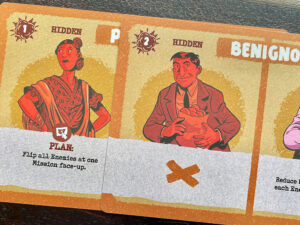
Before we get into the round structure, let’s visualize the setup. A random deck of mission cards is created when playing the high score option. Otherwise, each scenario instructs you as to how to build the mission deck. Four missions are placed faceup on the table and their associated enemies are added above them. The Civilian deck is shuffled and kept close by. Then players can choose to either draft their maquis or deal them out randomly. Three spy cards are shuffled into the final maquis deck.
To begin, you draw a hand of five maquis cards. Each card has two sides: hidden or revealed. Hidden cards are discarded at the end of the round and may feature a weaker attack power. The revealed side typically has a stronger attack power, but these cards are removed from the deck at the end of the round. Cards may also have a plan or attack action indicated, which is triggered during specific parts of the round.
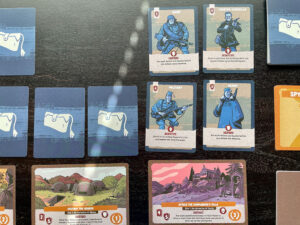
The first phase is Plan. Players may choose any card in their hand to play for its plan action. Plan actions allow players to draw a card, discard spies, flip enemies at a mission, and provide several other benefits. Once players have finished playing their plan cards to either the hidden or revealed areas, they then must choose one of the four mission cards to attack. All facedown enemies at the selected mission are revealed.
The second phase is Attack. Any enemy or mission effects that are labeled Defend are activated first. Then, players can play cards with an attack action. These may remove enemies, reduce the defense of the mission, or boost attack power. Players try to develop enough attack power to overcome enemy cards as well as the mission defense value. The mission can be defeated without defeating all enemies, but some enemies have a Survive effect that may injure civilians or remove maquis cards if left alive.
The third phase is Aftermath. Players must defeat the mission they selected or face the consequences. End game situations vary based on the type of game you’ve chosen to play, but typically if you fail two missions and/or lose five civilian casualties, the game is over. As such, you’re given the grace of one defeat before the resistance ends. A defeated mission is removed and replaced from the mission deck at the end of this phase.
If you were successful in the mission, the fourth and final phase begins. This is called Recover. Here you clean up your played cards, draw a new hand, and make one final end-game determination before the next round – if you have a full hand of spy cards (you start with three, but more can be added throughout the game), you lose.
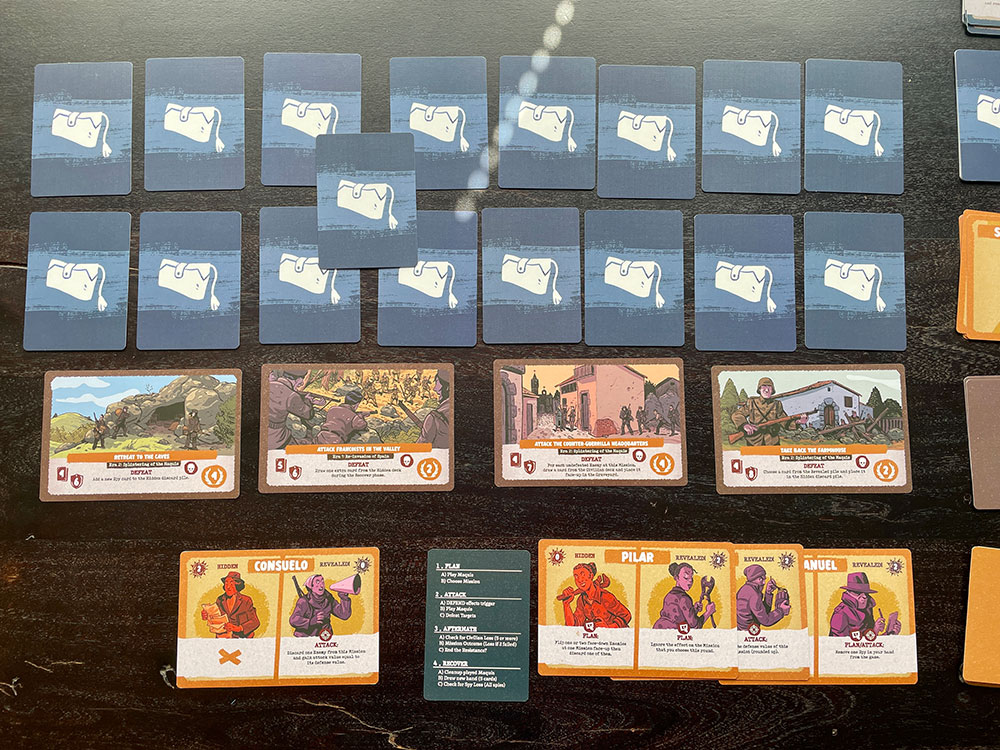
Game Experience:
Twelve cards. That’s all that you have standing between you and defeat. While each card is easy to understand, the choice of how to use it is not always clear. Nicolas is a great example. On his hidden side, he’s a gentle farmer with one attack power, but also the ability to draw another card. On a harder mission though, you may need him to reveal himself as a true warrior of the cause with four attack power. Which can only be used once before he’s removed from the game.
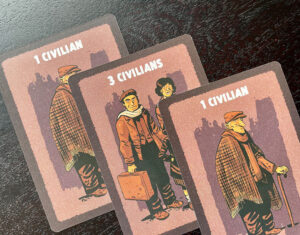
Resist! is all about efficiency. You may need to push your luck with a low attack draw action to try to boost your power. But the threat of spy cards, which effectively do nothing but clog up your deck, are always in your mind. In such a small game, theirs is a lot of deliberation in each phase. At the same time, there’s very little left to the imagination. You know the mission defense value. You know how many enemies are stalking about. You just don’t know how powerful they may be.
Unless of course, you find ways to reveal them via plan actions. The card interplay between perfect information and press your luck is the core mechanism you’re faced with. And based on your draw, you may end up with two spies and have little power. In those circumstances, the only thing you can do is hope for the best. Close your eyes and fall right into that mission with its unknown enemy defense values.
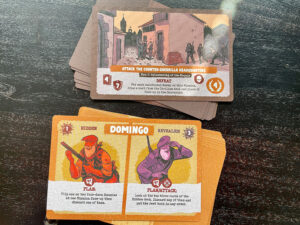
Enemy variety is not wide ranging, but there is enough to allow for strategic consideration. That said, there are typically many left unrevealed on the table and each mission choice comes with that frightful moment of what you may be facing. Do you have just enough attack power to take the mission location? You better hope you don’t reveal a Guard who you must defeat before you can even attempt the mission. Nearly lost all your civilians? A revealed Counter-Guerrilla card may cause an early exit.
Thankfully this comes with a scenario book. I’m not a fan of high score endings for solo games. But the scenario specific options provide specific objectives to overcome for victory. Without those, this would be a game that would leave the collection immediately. The eleven scenarios with objectives provide enough depth and challenge to keep you fighting.
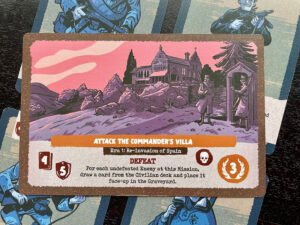
And you will fight. This is a difficult game. It requires planning and flexibility. It asks players to consider civilian loss as a necessity while at the same time leaving little room for error. The margin for error can be a little too punishing. At times it can turn the game into a min/max exercise, one that highlights the war of attrition while also lessening the impact of the unique maquis cards.
There’s also not enough depth in the rounds to create an evocative connection to these characters. You only go through your deck of cards a few times. Maybe in the end that is the point. Small moments of bravery from fellow civilian soldiers. Only for those moments to be forgotten as the pressure increases. The resistance continues. Until you’re down to the last cards. Anastasio is ready to shoot a jailer from the second story. Soledad desperately trying to open a lock. Their final moments. Against all odds.
Final Thoughts:
Resist! creates a memorable setting. This is highlighted further by the wonderful illustration and the punishing choices. It comes at a low price point and is worth the buy-in for the eleven scenarios. This is not a game I would recommend as a beat-your-own-score affair. It hovers on the edge of not having enough tricks up its sleeve. But perhaps adding anything else would minimize the focus. It’s steeped in the setting, providing plenty of historical context and wonderful touches, most notably the familiarity of your guerilla maquis. May they live long enough to bring Franco to his knees.
Final Score: 3.5 stars – A brutally punishing solo experience showcasing tight hand management with a focus on toppling a rising regime.
 Hits:
Hits:
• Thematic scenarios
• Drafting maquis
• War of attrition
Misses:
• Solo scoring
• Staying power
• Margin for error
Source: Board Game Quest





